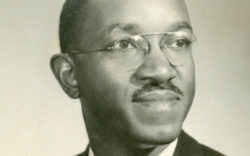The Ol’ Bloviator has delivered so many truly mind-numbing disquisitions on controversies over Confederate iconography that something akin to this downright demonic representation of Confederate Gen. Nathan Bedford Forrest has begun to haunt his dreams. (Not for nothing was this ugly-assed sucker selected as one of the world’s 10 most terrifying statues. True to his nature and calling, however, the O.B. refuses to let the fact that he doesn’t have much to add on a particular topic prevent him from cutting loose on it yet again, particularly when he is asked to do so, as he was a few weeks ago by the folks at Zocalo Public Square. What follows is a dramatically revised and expanded version of that piece.
The recent uproar in New Orleans over de-Confederatizing Southern public spaces succeeded once again in bringing out the worst in those who are emotionally over-invested in concrete representations of the leaders and key figures who stood on the wrong side of history more than 150 years ago.
Unlikely as it seems, the search for a useful parallel for understanding the historical and contemporary context of events in New Orleans may take us from the banks of the Mississippi to the banks of the Tigris. When Saddam Hussein’s Baathist Party came to power in Iraq in 1968, he undertook straight away to instill a sense of national pride and identity in his subjects by deliberately glorifying (and grossly embellishing) his own regime’s accomplishments while linking them to the supposed glories of ancestral antiquity. Pursuant to this end, he demanded that writers and visual artists present positive and compelling representations of Iraq’s past and present, stretching back all the way to ancient Mesopotamia and classical Islam, to be supplemented later by a variety of overpowering monuments such as the Arc of Triumph, formed by gigantic hands holding swords, and designed to pay tribute to a claimed victory in the Iran-Iraq War. All of this was meant to instill nationalistic fervor as a means of securing support or at least tolerance of Saddam’s tyrannical and reckless leadership.
Despite the differences in time and distance, there is a certain similarity between Saddam’s tactics and those of postbellum Southern leaders, who sought to instill a sense of quasi-nationalistic pride and purpose among white Southerners by rallying them around a glorious if illusory past, embodied in the Lost Cause and its valorous defense of the genteel and aristocratic Old South. Tirelessly invoking this seductive imagery, politicians drew on it to rally whites behind their efforts to strip blacks of their political, legal and civil rights. The move to monumentalize the Lost Cause often went hand-in-hand with campaigns for segregation and disfranchisement that, replete with incendiary rhetoric, more than once fueled outbreaks of mass violence against blacks.
An ex-Confederate and former North Carolina congressman, Alfred Moore Waddell worked tirelessly to secure monuments to the state’s “fallen sons,” while warning that the only real means of preserving their heroic legacy was denying black men the vote by any means necessary, even if “we have to choke the Cape Fear [River] with carcasses.” These chilling words foretold Waddell’s role as the principal instigator of the infamous Wilmington, NC riot of 1898, which left at least two dozen blacks dead.
Likewise, guardians of a Jim Crow system that prevailed well past the middle of the 20th Century played on Lost Cause loyalties in making the defense of this sinister arrangement the litmus test of loyalty to “our forefathers” and to “the Southern way of life,” suggesting just how deeply the institutions of white supremacy had been embedded in the notion of a distinct Southern white identity over the stretch of several generations. When the Civil Rights era finally toppled the formal barriers to racial equality, it was not surprising that white Southerners who could not accept the finality of this result and fought to reverse the irreversible continued to cloak themselves in the Confederate flag and other trappings of the Lost Cause. Yet even among the majority of white Southerners who made their peace with Jim Crow’s demise, there was a reluctance to go full cold turkey on their allegiances to the Lost Cause ethos, lest they surrender all that remained of what defined their cultural identity.
It took way too long, of course, but their insistence that continued affinity for Confederate symbols could be grounded in “heritage” rather than “hate” finally became blatantly untenable. Rebel flags and Confederate monuments had dominated the grounds of courthouses where such mockeries of justice such as the 1955 trial of the murderers of Emmett Till and the 1964 trial of the slayers of four civil rights workers in Philadelphia, MS played out. In the aftermath of the grisly slaughter of nine black parishioners in Charleston, SC, it became inescapably clear that Lost Cause iconography and paraphernalia had been a central thread in a lengthy but tightly interwoven tapestry of racial oppression and injustice. The Charleston massacre forced many white Southerners at long last to weigh the abstractness of heritage against the concreteness of hate, leaving them little choice but to withdraw, however grudgingly at first, from the active defense of Confederate symbols, largely leaving the field to an outnumbered, under-resourced minority for whom white supremacy was all that was left of their identity to defend.
Perhaps that is why, for all the death threats and precautionary measures that marked recent events in New Orleans, the proceedings gave off more than a whiff of fait accompli. It was particularly noteworthy that, while the removal of the first three monuments was accomplished in the dead of night, the fourth and most significant extraction, that of none other than the iconic Robert Edward Lee, came in broad daylight and on a pre-announced schedule. Make no mistake about it—this was no mere takedown of a another memorial to a Confederate general, but rather a benchmark event, in that it was a high-profile removal from a high-profile location of a monument to the highest-profile Confederate of them all.
Lee’s posthumous anointment as the symbolic embodiment of the Lost Cause was but a prelude to his acceptance into the national pantheon, as well. As white America in general rushed to embrace the romantic vision of Southern gallantry and devotion, Lee’s star shone ever brighter in the national firmament, commanding the admiration of several U.S. presidents, including both Roosevelts and Dwight D. Eisenhower, who hung Lee’s portrait in the Oval Office and praised him for being “noble as a leader and as a man and unsullied as I read the pages of our history.”
Even as Eisenhower rendered this high compliment, however, “the pages of our history” were being re-written. Lee’s aura of nobility and strength had insulated him from his undeniable role as leader of the fighting forces of a nation whose self-described “cornerstone” was slavery, but with historians and those who took them seriously finally ready to confront the reality that the Civil War was fought over the institution of human bondage, his pristine personal aura no longer loomed large enough to obscure his connections to a monstrous human evil. His name began to disappear from public schools, parks and thoroughfares some 20 years ago, but monuments bearing his likeness have been slower to give way, as if he represented the final sacrosanct pillar supporting the crumbling infrastructure of Lost Cause mythology.
Though it drew more attention, the removal of Lee’s statue in New Orleans actually conveyed less of a sense of finality than the decision to do the same in Charlottesville, VA, scarcely 100 miles south of his birthplace, where torch-bearing opponents of the move gathered recently to hear white nationalist Richard Spencer, sparking a candlelight counter-protest in which a Black Lives Matter banner was laid at the statue’s base. Legal action has guaranteed that the statue will stay put for six months, but if the ultimate failure of such efforts in New Orleans is any guide, Gen. Lee and his storied mount, Traveler, will soon be on the move in Charlottesville as well.
Beyond these moves to evict Lee’s likenesses, there are other reasons to suspect that, at long last, the days of Confederate monuments occupying well-known public spaces might be numbered. Since the Charleston massacre two years ago, at least 60 other Confederate symbols have reportedly been removed from such spaces. Confederate Memorial Day is no longer observed as such in Georgia, and the holiday is under fire in Arkansas and other states as well. There will be rear-guard counteroffensives, to be sure, as attention-seeking legislators seek to reinstitute Confederate holidays or impose legal restrictions on the removal of Confederate monuments, but the broad sense that symbolic tributes to the Confederacy will soon be much less central to Southern representative culture is hard to shake.
If reaching this point in what has been a protracted and often agonizing process has triggered a certain splintering of Southern white identity, then it is a small price to pay, compared to the benefits of forging a more just and inclusive society. Such a society had of course been the aim of those who succeeded in overthrowing Saddam in Iraq, and they quickly launched a radical and sweeping effort to de-Baathify the country by purging the government and its bureaucracy of former party members and erasing the cultural and architectural remnants of the historical memory that Saddam had constructed in the interest of fostering national unity and pride.
This zealous campaign soon raised concerns, however, including the specter of an unraveling social fabric across a population already marked by significant and contentious ethnic and religious divisions. The situation only grew worse when de-Baathification seemed to set the stage for wanton looting and depredation of some of Iraq’s most precious antiquities, some of it driven by a variety of lingering sectarian animosities. Iraqi art expert Nada Shabout conceded that “Some of the [Baathist] monuments were in bad taste and were ugly, and I would not be heartbroken if they were brought down. But… they were nevertheless part of the history of the country… So do we throw away the baby with the bath water?”
While the immediate consequences of de-Confederatizing Southern public spaces are unlikely to prove even remotely as severe in this country, events in Iraq represent yet another addition to a list of particulars stretching back many centuries of the complexities and frequently unintended consequences of attempting to erase disturbing reminders of an imperfect past.
Monuments to the defenders of slavery are nothing if not disturbing, all the more so because they were also the instruments of the people who brought us the watered-down version of slavery that was Jim Crow. Yet in this respect, while, like Saddam’s memorials, they may no longer be acceptable as public historical symbols, they nonetheless retain a distinct and indelible value as historical artifacts. Placed in museums or other suitable venues where they can be appropriately contextualized, they might succeed in persuading whites that they don’t belong on public property, while persuading blacks that they should not be destroyed.
The spirit of an ambitious campaign by historic preservationists at the Atlanta History Center and elsewhere to properly contextualize Confederate monuments is embodied in a tablet affixed last October to the base of a Confederate monument on the campus at Ole Miss. While respectful of the idea of honoring “the sacrifice of local Confederate soldiers,” the tablet also cautions that such monuments “were often used to promote an ideology known as the ‘the Lost Cause,’ which claimed that the Confederacy had been established to defend states’ rights and that slavery was not the principal cause of the Civil War.” In addition to a reminder that the Confederacy’s defeat “meant freedom for millions of people,” the plaque also notes this particular monument’s divisive legacy as “a rallying point for opponents of integration” on the evening of the deadly riot that marked James Meredith’s arrival on campus in September 1962.
Here, in and between the lines on this tablet, lies a truly compelling argument for preserving and fully articulating the origins and implications of these notorious pieces of concrete. Modest as it might seem, this effort might be a step toward the day when white and black Southerners not only find a way to share their common but traditionally conflict-ridden past, but to make it the foundation of a new and profoundly more representative regional identity. If this should indeed come to pass, the Lost Cause will have given way to one infinitely more inclusive and inspiring.
Like what you just read? Support Flagpole by making a donation today. Every dollar you give helps fund our ongoing mission to provide Athens with quality, independent journalism.










